Sudbury was the 19th town in the Massachusetts Bay Colony, and the third beyond the flow of the tide (after Concord and Dedham). It was originally bounded on the east by Watertown, on the north by Concord, and on the south and west by unclaimed lands. Our ancestor Edward Johnson of Woburn wrote in his book "Wonder Working Providence" that "This town is very well watered, and hath store of plow-land; but by reason of the oaken roots they have little broke up, considering the many Acres the place affords; but this kinde of land requires great strength to break up, yet brings very good crops, and lasts long without mending. . . . The place is furnished with great plenty of fresh marsh, but, it lying very low, is much indamaged with land floods, insomuch that when the summer proves wet they lose part of their hay; yet they are so sufficiently provided that they take in cattle of other towns to winter."
 Before Sudbury was founded, the "Old Connecticut Path" passed through on its way from Watertown to the western part of the state. The founders of Connecticut undoubtedly used this path in their migrations from Cambridge, Watertown, and Dorchester in 1633-1636. With the influx of so many new settlers during the Great Migration, Watertown soon became crowded. When some settlers in Watertown started looking for a new place to start a plantation, they naturally chose the land along the path just to the west of Watertown. The land grants for the plantation were approved by the General Court in 1637, and the name Sudbury incorporated in 1638. The settlement began on the east of the Sudbury River, in what is now the town of Wayland. Settlement started west of the Sudbury River about 1650. "Open field" or communal farming was practiced in Sudbury as was the tradition in central and western England. However 13 settlers prefered the "closed field" or owner-operator farming as practiced in eastern England, and in 1656 they successfully petitioned the General Court to create the new town of Marlborough just to the west of Sudbury.
Before Sudbury was founded, the "Old Connecticut Path" passed through on its way from Watertown to the western part of the state. The founders of Connecticut undoubtedly used this path in their migrations from Cambridge, Watertown, and Dorchester in 1633-1636. With the influx of so many new settlers during the Great Migration, Watertown soon became crowded. When some settlers in Watertown started looking for a new place to start a plantation, they naturally chose the land along the path just to the west of Watertown. The land grants for the plantation were approved by the General Court in 1637, and the name Sudbury incorporated in 1638. The settlement began on the east of the Sudbury River, in what is now the town of Wayland. Settlement started west of the Sudbury River about 1650. "Open field" or communal farming was practiced in Sudbury as was the tradition in central and western England. However 13 settlers prefered the "closed field" or owner-operator farming as practiced in eastern England, and in 1656 they successfully petitioned the General Court to create the new town of Marlborough just to the west of Sudbury.
Relationships with the local Indians were excellent, and the Indians lived peaceably in the northeast section of Marlborough. This ended when King Philip's war broke out in 1665. There is no indication that the local Indians ever participated in the war, but roving bands of Indians under King Philip's control led to nightmare conditions for the settlers in Sudbury and Marlborough. Marlborough was an intermediate post between Boston and the Connecticut River settlements, and a fort had been established there before the war and served as a depot for provisions and munitions. When the Indians ambushed a group of soldiers north of Hadley, Captain Hutchinson was wounded and carried to Marlborough, where he died and was the first person buried in the old burying ground. In Feb. 1666 the Indians attacked Lancaster, Medfield, and Groton. On March 26 they attacked Marlborough and burned 13 houses, 11 barns, and the meeting-house. On April 18 they attacked Sudbury and burnt most of the town during the "Sudbury Fight". By this point virtually all of the residents of Sudbury and Marlborough dispersed to other towns such as Concord and Watertown for the remainder of the war.
 The first two settlers in what is now Stow came between 1650 and 1660. On Oct 13, 1669, the General Court appointed 5 men to report about the suitability of starting a settlement there. Some land grants were made in 1672, but King Philip's War took a heavy toll on settlement of this region. Both Sudbury to the south and Lancaster to the west were devastated during the war, and new settlers were reluctant to come to the area even after the War was over. Legend says that during the war Indians met on Pomciticut Hill (what is now Summer Hill in Maynard, on our ancestor TIMOTHY GIBSON's future land) to decide who to attack next, Sudbury or Concord. One of them said Concord was led by too powerful a man (Rev EDWARD BULKELEY, our ancestor) and the Great Spirit would be offended if Concord was harmed, so they attacked Sudbury. Settlers slowly moved back to Stow after the war, and finally Stow was incorporated in 1683. Over the years, its land was carved up and given to new towns: Harvard, Shirley, Boxborough, Hudson, and Maynard.
The first two settlers in what is now Stow came between 1650 and 1660. On Oct 13, 1669, the General Court appointed 5 men to report about the suitability of starting a settlement there. Some land grants were made in 1672, but King Philip's War took a heavy toll on settlement of this region. Both Sudbury to the south and Lancaster to the west were devastated during the war, and new settlers were reluctant to come to the area even after the War was over. Legend says that during the war Indians met on Pomciticut Hill (what is now Summer Hill in Maynard, on our ancestor TIMOTHY GIBSON's future land) to decide who to attack next, Sudbury or Concord. One of them said Concord was led by too powerful a man (Rev EDWARD BULKELEY, our ancestor) and the Great Spirit would be offended if Concord was harmed, so they attacked Sudbury. Settlers slowly moved back to Stow after the war, and finally Stow was incorporated in 1683. Over the years, its land was carved up and given to new towns: Harvard, Shirley, Boxborough, Hudson, and Maynard.
In the following descriptions, the direct ancestors (not including siblings) are given in capital letters.
|-
|-Thomas |
| Brigham-|
Mary | |-Mercy
Brigham-| |-John Moore
| |-Elizabeth Moore-|
| |
|-Mary Rice-|
| |-Edmund Rice
|-Henry Rice -|
|
|-Samuel Rice -|
| |-Thomasine Frost
Hannah Rice-|
| |-Thomas King
|-Elizabeth King -|
|-Ann Collins
Sudbury was started by enterprising settlers from Watertown, but most of the permanent settlers came to Sudbury straight from England. Our ancestor EDMUND RICE is listed on a Sept 8, 1638 petition which requested land for a new settlement. The list of the first 56 settlers who were at Sudbury by 1639 includes both EDMUND and his son HENRY RICE. A list of 22 more settlers who arrived soon after the settlement began includes 2 more of our ancestors: THOMAS KING and JOHN MOORE. In 1655 when new grants of land, 130 acres each, were given to 50 Sudbury settlers, all four of the above ancestors were included, plus three of their sons. So it is an understatement to say that our ancestors played an important part in the early settlement of Sudbury.
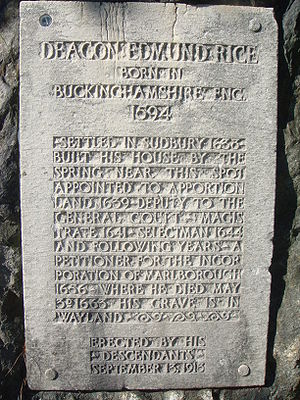
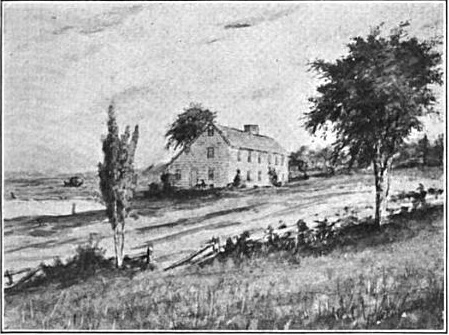
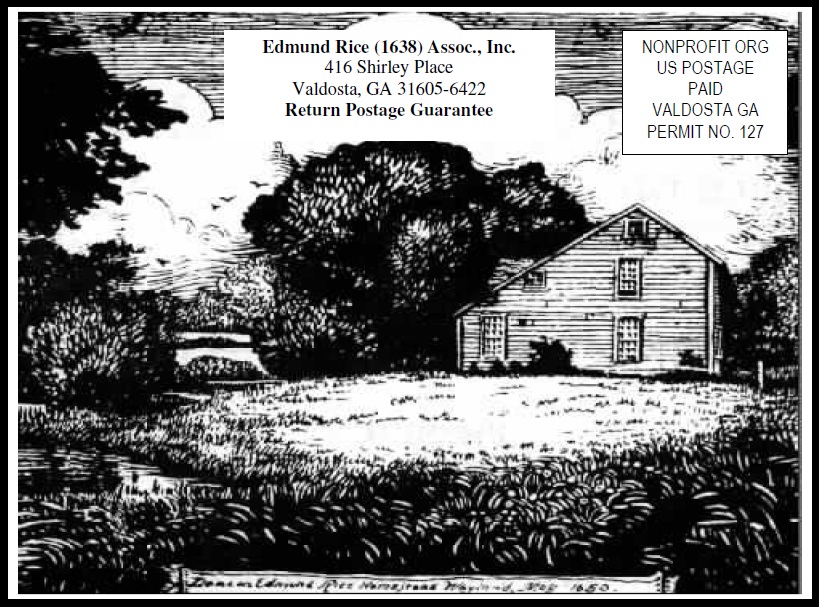
Historical road marker and two views of the Edmund Rice homestead in present day Wayland
(left view from "Historical reminiscences of the early times in Marlborough, page 157)
The most prominent of our Sudbury and Marlborough ancestors was EDMUND RICE, who was born in 1594 and married THOMASINE FROST in 1618 in Barkhamstead, England. They had 11 children, nine of them boys and ten of them born in England. They came to Massachusetts in 1638. THOMASINE died in Sudbury in 1654, and the following year EDMUND married Mrs MERCY BRIGHAM of Cambridge, and they had two daughters. See the Cambridge chapter for more on the BRIGHAM family.
EDMUND immediately played an important role in the new community when he was appointed Sept 4, 1639 to lay out the roads and lots of Sudbury. He served as selectman from 1639-1644. He became a freeman on 13 May 1640, and elected as a deputy of the Great and General Court in October of that year. He was appointed a Judge of Small Causes for the Sudbury district on 2 Jun 1641. In 1648 he was ordained as a Deacon in the Puritan Church at Sudbury. He was reelected as a deputy of the General Court in 1652 through 1654. In addition to his prominence in the political and religious life of the community, he also became the largest landholder in Sudbury. His first house was just seven lots northwest of the first meeting house in Sudbury, along what is now called Old Sudbury Road in the town of Wayland. He sold it Sept 1, 1642 and for the next six years leased the 600 acre Dunster Farm, which was owned by the first president of Harvard College. He then bought several parcels of land west of the Mill Pond just north of Wayland Center along Concord Road. This became known as the Rice Homestead since he sold it to his son and it was owned by several Rice generations. On Sept 26, 1647, EDMUND leased the 600 acre Glover Farm for 10 years. Part of the terms of this lease were that EDMUND had to build a house and barn with the specifications: "30 foot long, 10 foot high, 1 foot sill from the ground, 16 foot wide, with two rooms, both below or one above the other, all the doors, walls and staires with convenient fixtures, and well planked under foot and boored sufficiently to lay corn in the story above head." And the barn "fifty long, eleven foote high in the stud, one foote above ground, the sell twenty foote if no leantes or eighteen foote wide with leantes on the one side, and a convenient threshing-floare between the doares." These buildings were near Dudley Pond on the part of the Glover Farm that is now in Wayland, however at least one history book claims the house was the first dwelling in what is now the town of Framingham. On April 8, 1657 he purchased the 200 acre Jennison Farm to the east of the Dunster Farm, and a couple years later he and his son purchased the Dunster Farm. He also received about 130 acres nearby in three different land grants called the "Rice Grants", situated about a mile from Cochituate Brook. This corner of what is now Framingham, where Rice Road is located, was called "Rice's End".



Rice memorial stones and an historical marker at the Old North Cemetery in what is now Wayland Center.
 EDMUND was the driving force in the creation of the town of Marlborough. He moved there in 1656 with his new wife MERCY (painting at right) and some of his children, and immediately was elected a selectman and alloted 50 acres as one of the largest landholders. EDMUND only lived a few years in Marlborough as he died in 1663. He was buried at the Old North Cemetery behind the Sudbury Meeting House close to his first house in Sudbury, probably alongside his first wife and mother-in-law. EDMUND's estate was valued at £743.8.4 pence (the inventory was done in part by THOMAS KING). Through his nine sons the Rice surname flourished in Sudbury and Marlborough for many generations. There is even an "Edmund Rice (1638) Association" that currently carries out historical research and holds yearly reunions. Among his many descendents was President Calvin Coolidge. MERCY married William Hunt when EDMUND died, and she died in Marlborough in 1693.
EDMUND was the driving force in the creation of the town of Marlborough. He moved there in 1656 with his new wife MERCY (painting at right) and some of his children, and immediately was elected a selectman and alloted 50 acres as one of the largest landholders. EDMUND only lived a few years in Marlborough as he died in 1663. He was buried at the Old North Cemetery behind the Sudbury Meeting House close to his first house in Sudbury, probably alongside his first wife and mother-in-law. EDMUND's estate was valued at £743.8.4 pence (the inventory was done in part by THOMAS KING). Through his nine sons the Rice surname flourished in Sudbury and Marlborough for many generations. There is even an "Edmund Rice (1638) Association" that currently carries out historical research and holds yearly reunions. Among his many descendents was President Calvin Coolidge. MERCY married William Hunt when EDMUND died, and she died in Marlborough in 1693.
THOMAS KING was a contemporary of EDMUND RICE. He was born in 1600 in Shaston, England, married ANN COLLINS, and the couple with their two young children came to Sudbury by 1642. (Note there is another Thomas King who owned land in Watertown at this time across Washington St. from the Chenery School in current Belmont, and who helped start Lancaster; that Thomas King died in Watertown in 1643.) Their third child, Thomas, was born on Dec 4, 1642. Sadly, the mother ANN died three weeks later on Dec 24, and Thomas, without a mother to nourish him and take care of him, died shortly after his second birthday. The family lived along the Sudbury River, and in 1643 the first cart-bridge to cross the river was built adjacent to his land. In 1655 he was alloted 130 acres in the 2-mile lots on the western edge of Sudbury. His lot was the second lot from the southern boundary of Sudbury, the first lot being the cowpen. The famous Wayside Inn was later built on the adjacent lot to the north. Also in 1655 THOMAS married Bridget Davis (Dec 26), and his daughter ELIZABETH KING married EDMUND's son SAMUEL RICE (Nov 8). With the KING and RICE families joined in matrimony, it is not at all surprising that the following year THOMAS KING signed the petition along with EDMUND RICE to create Marlborough, and THOMAS was one of four chosen to "put the Affairs of the said new Plantation in an orderly way." In 1657 he was elected with EDMUND to be selectmen of Marlborough, which positions they held until 1664, and in 1660 was granted a houselot of 39 acres. In 1664 THOMAS and SAMUEL along with seven others petitioned for permission to establish a church, and in 1665 the two in-laws were listed as being part of a meeting concerning the defense of the town during the King Philip's War. In 1671 THOMAS headed a petition for land grants south or southwest of Marlborough, which was denied. He made his will out on Mar 12, 1676, and probably died soon after that. His widow Bridget died in Marlborough in 1685.



left: A drawing of the Edmund Rice home on Glover Farm,
based on the written description of the house and barn ("Puritan Village", page 93)
middle: looking over the Sudbury River. Thomas King had his lot on the far bank, near the bridge.
right: The mill at the Wayside Inn; Thomas King owned the land south of the road including where the mill is located.
JOHN MOORE was also a contemporary of EDMUND RICE. He was born around 1610 in Henham, Essex, England, and came to Sudbury by 1642 when he bought a house and land from EDMUND RICE. His first wife, BRIDGET, died in England after having two children including ELIZABETH, who married EDMUND's son HENRY RICE on January 1, 1643/4. JOHN MOORE then remaried and had six more children, most of them born in Sudbury. He was a farmer who took an oath of fidelity July 8, 1645 but does not otherwise appear in the records until his will, dated Aug 25,1668, was probated April 7, 1674 shortly after his death on Jan 6. His estate was valued at £804.7.0.
HENRY RICE, oldest son of EDMUND and THOMASINE RICE was already a man when he came with his father to America, and was considered one of the original settlers of Sudbury. He was granted a homelot southeast of his father's lot just a quarter mile from the first meeting house. He was also granted in 1655 lot #31 (130 acres) in the 2-mile lots on the western edge of Sudbury, quite a ways north of THOMAS KING's lot. In 1659 his father gave him some land at Rice's End, where HENRY built a house. In 1645 he is listed as taking an "oath of fidelity", and in 1652 he was selected to sit on a grand jury. Sudbury was one of the towns that were destroyed during King Philip's War, and HENRY was on the list of damages with a value of £180. He became a Corporal in 1686, and is described as "Corp. Henry Rice" on a 1688 list of men who received ammunition from the public stock. His home became a part of Framingham when it was incorporated in 1700, and thus HENRY died in 1710 in the town of Framingham. He married ELIZABETH MOORE in 1643 and they had ten children, including MARY RICE who was born in 1646.
MARY married her grandfather's step-son, THOMAS BRIGHAM who was only five years older than her. THOMAS came to Marlborough with his mother, MERCY, when she married EDMUND RICE. THOMAS eventually settled in the southwest part of the town on the south road to Northborough. He built a house there after King Philip's war that stood for generations. Their youngest daughter, MARY, born in 1687, married JONAS HOUGHTON of Lancaster (read the Lancaster chapter for more on the HOUGHTON's). The chair THOMAS died in is now owned by the Marlborough Historical Society.
SAMUEL RICE, seventh son of EDMUND and THOMASINE RICE, was also our ancestor, though it would be 6 more generations before descendents of HENRY and SAMUEL RICE would marry. SAMUEL was added to the list of proprietors of Marlborough in 1657, and was granted a houselot of 21 acres in 1660. He and ELIZABETH KING had six children including HANNAH born in 1658. Two weeks after their 6th child was born, ELIZABETH died on Oct 30, 1667, one more sad instance of a mother dieing from the complications of childbirth. SAMUEL married Mary (Dix) Brown the following year and had four more children. The family temporarily moved to Concord during King Philip's War, where Mary died in 1675. SAMUEL married yet again, to Sarah (White) Hosmer, and they had one child born in Concord in 1678. HANNAH RICE must have met her future husband, JONATHAN HUBBARD, during this time in Concord, and she is described in more detail in the Concord chapter. SAMUEL died back in Marlborough shortly before his will was probated on April 1, 1685. The inventory of his estate was £349.2.6.
|-Isaac Miller
Mary Miller-|
|-Priscilla Ball
We know very little about the Miller family. Isaac was born in Charlestown in 1670, and Priscilla was probably born in Concord about 1676. They were married in Concord on Jan 6, 1696, and appear in the Sudbury records for six children born in Sudbury between 1696 and 1710. Their first daughter, MARY, married JOSEPH PRIEST of Lancaster in 1715, and will be described more in the Lancaster chapter.
|-Timothy Gibson
|-Abraham Gibson-| |-Stephen Gates -|
| |-Rebecca Gates -| |-Ann Hill
Abraham Gibson-| |-Sarah Woodward
| |-Deliverance Wheeler
|-Mary Wheeler -|
|-Mary Davis
Unlike Sudbury and Marlborough, Stow was a second-generation town, meaning that none of our ancestors who lived in Stow emigrated from Europe. However the first of our ancestors involved with Stow was THOMAS WHEELER who emigrated from England to Concord and who signed several petitions involving the formation of Stow before King Philip's War. However he died just after the war and did not have the chance to live there. His son, DELIVERANCE WHEELER, moved to Stow sometime after his marraige to MARY DAVIS in 1691 and the birth of their first child in Concord in 1692. Their daughter MARY was born in Stow in 1707. DELIVERANCE died there Feb 4, 1715/6, and is buried in the Lower Village Cemetery, while his wife MARY lived in Stow another 32 years until Jun 27, 1748.
The Gates family story has been mentioned in both the Hingham and Cambridge chapters. In 1638 the family emigrated from England to Hingham, where STEPHEN was born in 1640. In 1653 the family moved to Cambridge, followed the next year to Lancaster. They eventually returned to Cambridge where the father died in 1662 and STEPHEN married SARAH WOODWARD of Watertown in 1664. They lived for awhile in Boston, Cambridge, and Charlestown. In 1673 he purchased from Edward Drinker 300 acres of land on both sides of the Elsabeth Brook in Stow around Spindle Hill, which became known as the "Gates Farm". The next record we have of the family is that their three youngest children were born in Marlborough between 1679 and 1685, including REBECCA in 1682. However I wonder if they were actually living on the Gates Farm then, but since Stow was not yet a town, and did not have a church, the births were recorded in the nearest town. His mother ANN lived with the family, and is recorded as dying in Stow on Feb 5, 1682/3, before the youngest child was born in Marlborough. In 1684 STEPHEN once again bought the 300 acre property in Stow, this time paying 40 shillings to Benjamin Bowhoe, an Indian of Pompacittaquutt (it was customary for the settlers throughout all of Massachusetts to insure a clean title by buying land from the local Indians, usually done for an entire town near the time of incorporation). STEPHEN died on this farm in 1707 and his will left it to his six sons. The Gates family lived on part of the land for eight generations in a house within sight of "Elsbeth Brook". STEPHEN, his wife SARAH, and daughter REBECCA, and probably his mother ANN, are buried in the Lower Village Cemetery along with numerous other Gates descendents.
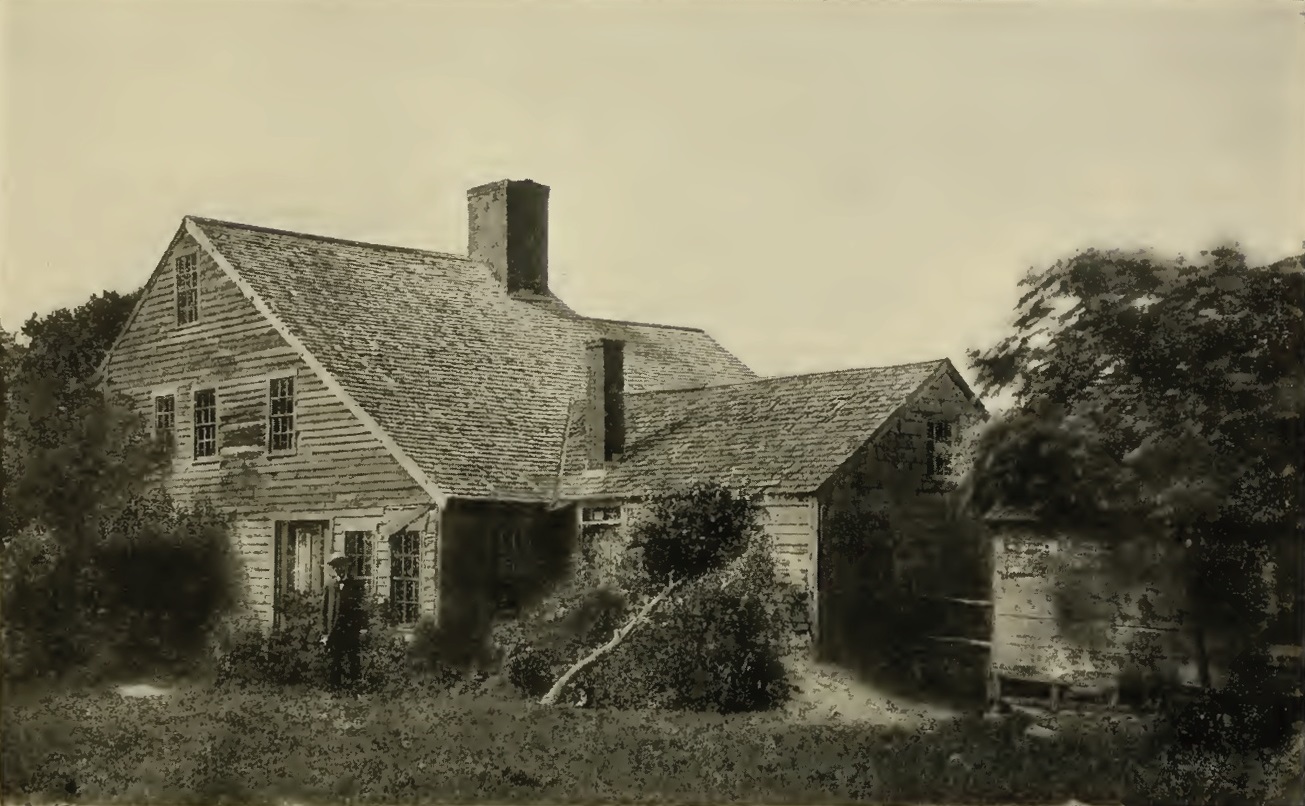
The old Gates Homestead in Stow, first owned by Stephen Gates. (Photo from the book "Silas Gates of Stow Mass.", 1907)
The start of the Gibson family story is told in the Cambridge chapter, and is one of the more interesting sagas with witches, smallpox, and the oldest gravestone in Cambridge. TIMOTHY GIBSON was born in Cambridge in 1679, but when his father died of smallpox, TIMOTHY was raised by Abraham and Sarah Holman, who had no children of their own. The Holmans moved to Stow in 1689 where they owned considerable land in both Stow and Sudbury. TIMOTHY lived with them until 1703 when they gave him a 60 acre farm in Sudbury. They later gave him another 30 acres, and yet more in their wills. TIMOTHY became a prosperous farmer with his farm straddling the Stow/Sudbury border and with additional land in Lunenburg and in Cambridge ("Arrington's lot", which must have been from his mother's parents). His farm is now in the town of Maynard, on the southern slope of Pomciticut hill. On Nov 17, 1700, he married REBECCA GATES, and they had 12 children. Their first child, ABRAHAM born Sep 30, 1701, was recorded in Stow, whereas all of the rest were listed as born in Sudbury. But TIMOTHY was back in Stow as a selectman in 1734, 1735, 1736, and 1739, and a deacon of First Church in Stow. I don't know if the boundary between the towns changed, or whether he just moved his dwelling from one part of his farm to another. REBECCA died in 1754, TIMOTHY married Submit Taylor in 1755, and TIMOTHY died in 1757.
ABRAHAM GIBSON was named after Abraham Holman, and Holman's will gave him 25 acres of land in Stow. He married MARY WHEELER about 1724, and from then on he lived in Stow. In the next five years he acquired about 67 acres: 48 from his parents, 10 from his brothers-in-law Deliverance and Thomas Wheeler, and four from the proprietors of Stow. Their house was most likely near the Stow Center village, some distance from Pomciticut hill where he grew up. ABRAHAM was in Captain Nathan Bridgam's company in 1725, was assessor in 1733-4, constable 1735-6, and selectman 1732, 1733, 1739, and 1740. They had seven children before ABRAHAM died at the early age of 39. His estate inventory was near £1500. He and his parents are all buried in the Stow Lower Village Cemetery with gravestones. His wife MARY lived another 53 years in Stow, most of that time married to Deacon Daniel Hapgood, and was still living when her oldest daughter Mary's son, Captain Isaac Davis, was the first to fall at the old North bridge in the battle of Concord, April 19, 1775. Her son ABRAHAM, born 1735, was also a minuteman who marched on that same day. His story is told in the chapter on Lunenburg. He grew up in Stow, but soon after marrying ESTER FOX of Concord in 1760, he moved to Concord and then Fitchburg and Lunenburg.

Stow Lower Village Cemetery with gravestones for five of our ancestors. The blue arrow points to the cluster of seven stones shown below. ABRAHAM GIBSON is in the center of the cluster. Above him are his wife's parents DELIVERANCE and MARY WHEELER and their son Deliverance Wheeler Jr. Below him are his parents REBECCA and TIMOTHY GIBSON and TIMOTHY's second wife Submit.



Here Lyes ye Body | HERE LIES BURIED | Here Lies Buried
of Deliverance | YE BODY OF MRS | The Body of Mr
Wheeler Aged | MARY WHEELER | Deliverance Wheeler
53 Years who | RELIC WIDOW OF | Son of Mr Deliverance
Departed this | MR DELIVERANCE | & Mrs Mary Wheeler
life February | WHEELER WHO | Who Died Feb
ye 4th xxxx | DECD JUNE YE 27 | ye 25 1760 In
| A.D. 1748 | ye 68th Year of
| BEING NEAR | His Age
| 85 YEARS OLD |


Here Lies Buried
ye Body of Mr
Abraham Gibson
who depated
this life
Novembr ye 8th
AD 1740
age 39 years
1 M & 9 D



Here Lies Buried | Here Lies Buried | Here Lies Buried
The Body of | The Body of | The Body of
Mrs. Rebekah | Dean Timothy | Mrs Submit Gibson
Gibson Wife of | Gibson Who Died | Wife of Deac Timothy
Decn Timothy Gibson | July ye 14 | Gibson Who Died
Who Died January | AD 1757 in | January ye 29
ye 21 AD 1754 | Ye 79 Year of | 1759 In ye 75
In ye 73 | His Age | Year of Her Age
year of | |
Her Age | |
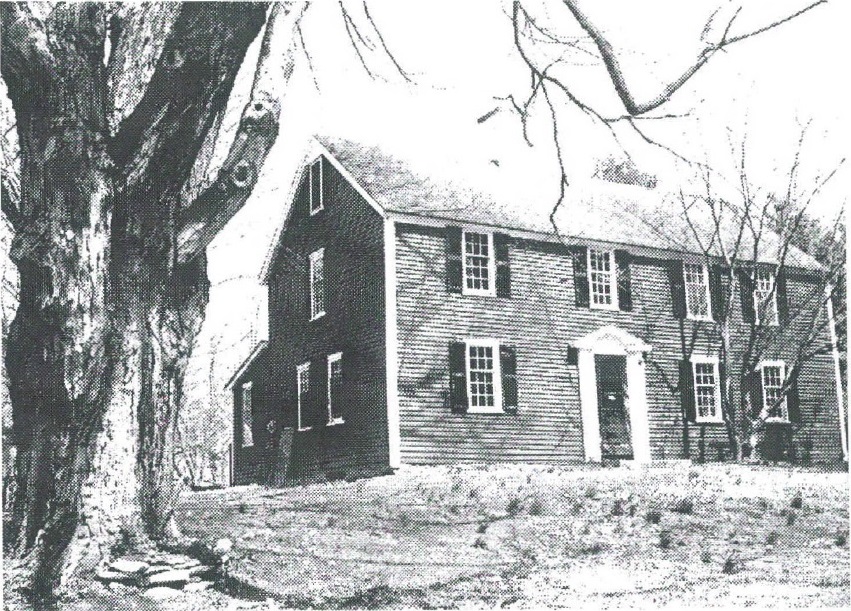
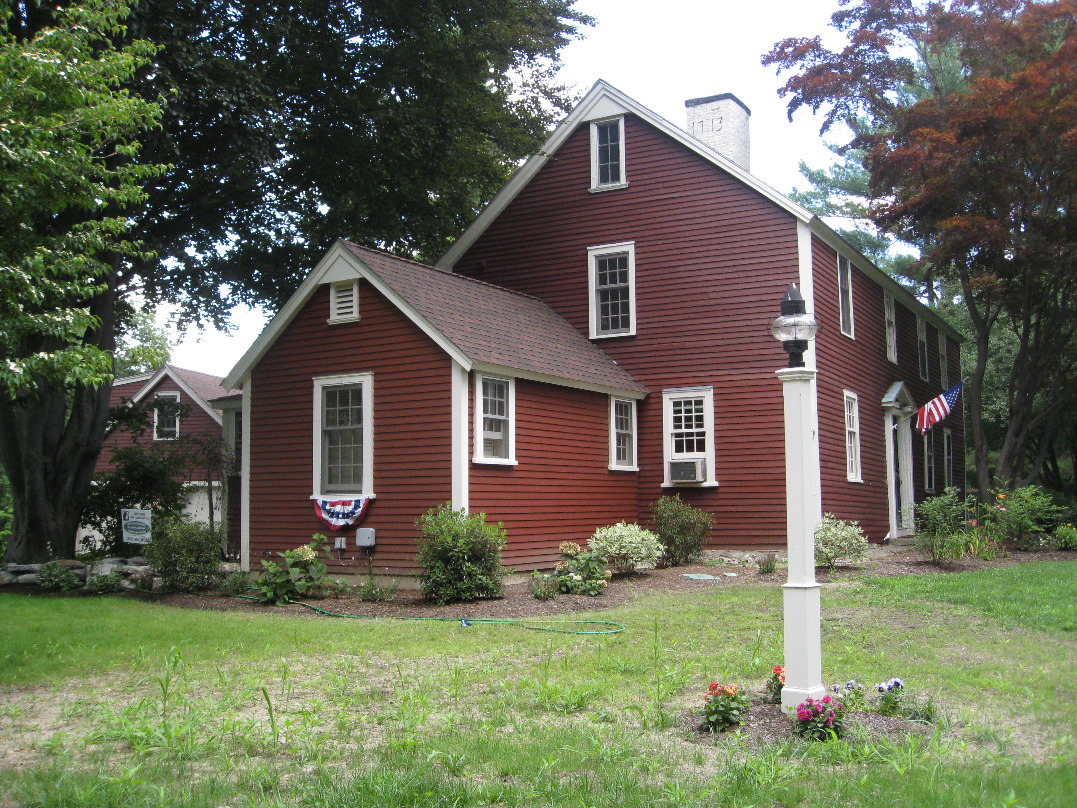
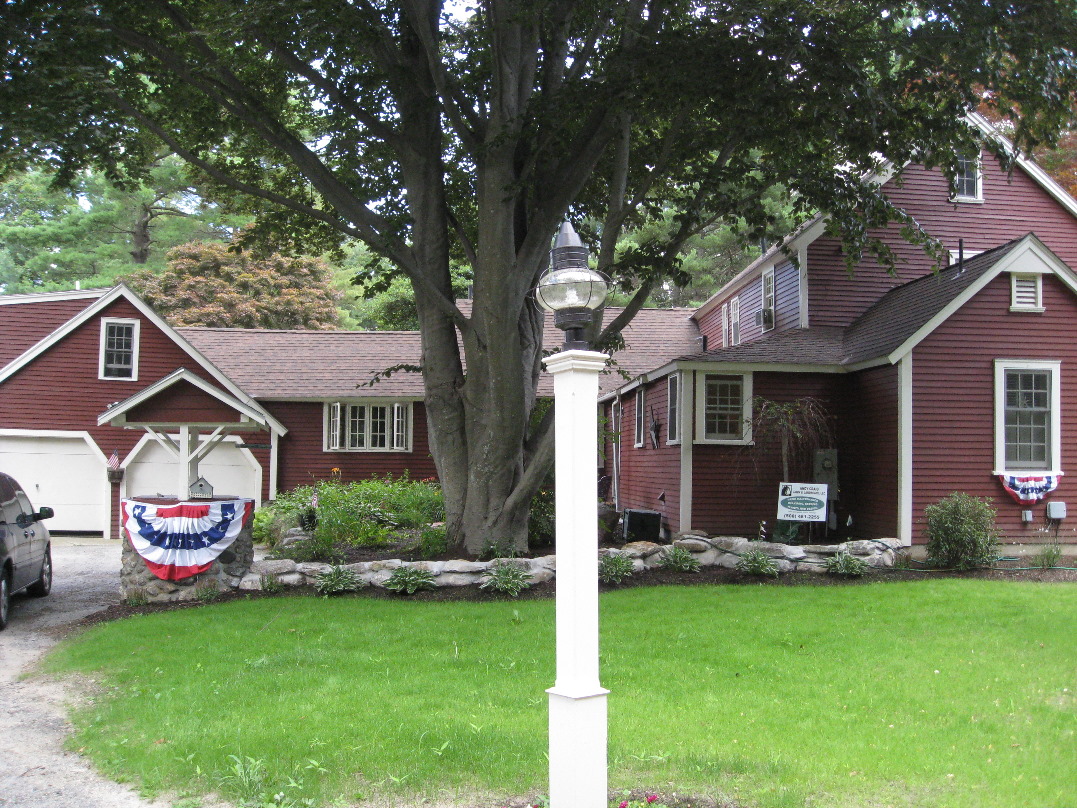
Stowe-Welch house on Spoon Hill Road where HORATION NELSON WELCH was probably living when he died. Photo on left was taken in 1970. The two photos on right taken in 2010. The right photo shows the back of the house with several modern additions.



Nine Welch graves in Rocklawn Cemetery. The center obelisk has the epitaphs on 4 sides. The H.N.W. small stone is in the shadow at the back right of the photo in the middle.
Bibliography
- "Puritan Village - The Formation of a New England Town", Sumner Chilton Powell, 1963
- "A genealogical history of the Rice family: descendants of Deacon Edmund Rice...", Andrew Henshaw Ward, 1858
- "Vital Records of Sudbury, MA to the year 1850", NE Historic Genealogical Society
- "The History of Sudbury, Mass, 1638-1889", Alfred Sereno Hudson, 1889.
- "Historical reminiscences of the early times in Marlborough, Massachusetts", Ella A. Bigelow, 1910
- "History of the Town of Marlborough, Middlesex County, Massachusetts", Charles Hudson, 1862
